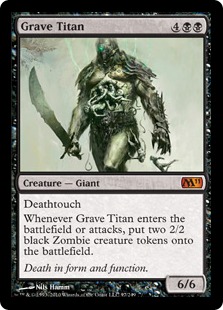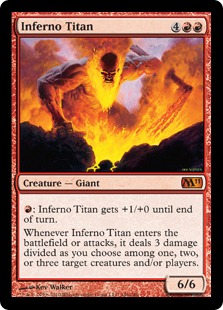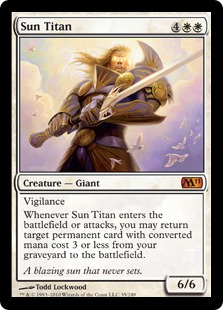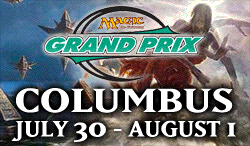First and foremost, a hearty thank you to Aaron Forsythe for shifting the way that Deathtouch works with the introduction of M11. I still have some issues with the M10 rules changes (though, all of which we can live with), but this is a great improvement from design-side considerations. The old rule (deathtouch is different with combat ordering) was kludgey and clumsy. The new rule can be summed up by this thought: ANY damage from deathtouch is considered lethal. Thus, there is no need for an exception for deathtouch when it comes to combat. I first brought up this idea in On M10, Combat, and Rule 5; a reader of Randy Buehler blog, “Arturo,” suggested it, and it is awesome to see such an excellent idea heeded by Wizards of the Coast. Whether they came to the idea on their own or as a result of Arturo’s suggestion, I find myself with high hopes for the possibility of Wizards listening to other smart, reasonable suggestions that might come up through the grassroots. Kudos!
Also, I want to offer up Joey Mispagel a congratulations for his performance at the StarCityGames.com Standard Open in St. Louis. I really wanted to attend myself (with a deck that would have been remarkably similar), but I was wrapping up some research on licensed games and authenticity (think to yourself what makes a game fit the tone of what it is doing, and what makes it just a cheap marketing ploy like Simpsons Monopoly) and various cultural studies work perspectives on The L Word. While it is awesome researching these things, it does mean that I’m missing out on far more tournaments than I’d like to.
That said, I do have some fun things coming up in Chicago. The shorter drive has me heading down to Chicago for the PTQ run by Alan Hochman and Pastimes Games instead of up to Minneapolis for the one run by Steve Port and Legion Events, and so I’ll be foregoing the Fourth of July celebrations in these necks of the woods in favor of fighting for a Q (likely with Mono-Red, though there are other decks in the running as well). And, the next week, on Saturday, July 10th, I’ll be gunslinging for Pastimes M11 Prerelease party, so that should be fun, too. I’m still not sure what decks I want to bring, but I have some ideas…
But, now, back to Joey Mispagel’s fantastic win with Mono-Red. Here is his list:
Creatures (18)
Lands (24)
Spells (18)
Sideboard

(Small side not to those as obsessed with deck names as I am: I definitely don’t consider this a RDW-archetype. While names sometimes go through flurries of different meaning, I’m a big fan of trying to maintain archetype names for the sake of utility. RDW, historically, implied some degree of mana control, usually in the form of Wastelands, Rishadan Ports, Molten Rain, and the like, depending on what was legal. This looks like a burn-heavy Sligh deck to me — though I grant that that categorization does cede the shift in the term Sligh around 1997 or 1998.)
Mispagel’s deck is a direct descendant, I think of Ian Kendall’s Top 8 deck from the StarCityGames.com Open in Seattle.
Creatures (18)
Lands (24)
Spells (18)

There are three obvious differences between the two. Mispagel has changed Forked Bolt to Earthquake (a change I definitely can get behind). He has also shift the lands around to include saclands, a clear improvement for a deck that includes Searing Blaze. His sideboard is the other difference, and perhaps the most radical one, only sharing the two Quenchable Fire as the dedicated anti-Jund slot.
I have very different opinions from both of these players with how the sideboard should function, but with regards to the main deck, I basically feel like this kind of shell is exactly where you want to be. Since the saclands are only supporting Searing Blaze, I’d be happy to see them cut down (somewhere between four and six copies, depending). Further, personally, I find Burst Lightning and Staggershock fairly underwhelming, but still useful, and I shave one of each off for another land and an Earthquake, but your mileage may vary.
I was playing my own version of the deck in online queues, prepping for the PTQ, when one opponent asked a very fundamental question:
“Why does anyone even play that deck?”
My opponent went on about how Red is only for scrubs, and it beats nothing.
This is the kind of claim that has me laughing in my seat at home. He was clearly making the complaint because we weren’t even done with game 1 yet, and he was sure he was going to lose the match (yay for whining!), but it was also clear to me that he really felt that way.
A part of the reason that I like to play Red is because of the expectations of certain matchups. Take Jund, for example. I know that unless they get quite lucky, or have a particularly antagonistic anti-Red board (and then get a little lucky), I’m likely to win. Jund isn’t particularly good at dealing with direct assaults on its life. In the last week, my record in sanctioned matches against Jund is 8-2.
What it boils down to is that Goblin Guide or a multiple-early Hellspark Elemental draw is deeply difficult for Jund to deal with. In many games, you’ll have Jund at 12 or lower and they haven’t even put a creature on the board. Now, you’re sitting with burn in your hand (and on the top of the deck), and you can just overwhelm them. Jund absolutely can win, but it isn’t likely.
Sovereign Mythic is another deck that you can expect to see in the field. If we use Jared Sylva analysis of the metagame, that matchup is basically 70-30 for Red. Why? In my experience, again, if they aren’t aggressively anti-Red, you can just plink off their early mana, while whittling away at their life total. Certainly, they can take the match, but it’s difficult.
So, now, so far, we have 30% of the field — the two most popular decks — as good matchups.
There is always the bad news; current build of Blue/White Control decks are a nightmare. But that’s certainly acceptable. At this point in the metagame, I don’t think you’ll be able to find a deck that has the kind of results that will give you great matchups across the board.
When we add in the reported good matchup results of Red versus Next Level Bant (though this seems more questionable to me) and Turboland (this seems very reasonable to me), Red looks like a deck choice that should be incredibly reasonable.
Now, of course, some more bad news: the bigger the target on Red’s face, the worse for it.
Red has an incredible glass jaw. I was playing against a White Eldrazi deck in one match, for example, and I utterly destroyed it in game 1. In games 2 and 3, however, he just overwhelmed me with sideboard hate. If a deck, even Jund, wants to beat Red, they can probably do it.
As it stands, then, I’m a bit torn. I know that I love Red as a deck, and that I can play it incredibly well. On the other hand, if there is any weekend in which Red might have a target on its head, this is probably the one. I guess we’ll just have to see which way I end up leaning…
The Giants
I’ve always loved the old phrase “standing on the shoulders of giants.” Usually it is taken to mean that by standing upon the shoulders of those giant figures before us in history, we can see even further than we could have without, and even further than even they might have been able. Of course, with the new Giant cycle in M11, it can take on a different meaning.
I was recently asked by some WotC folk which Giant was my favorite. At the time, it was the Red one, but largely because I had misread some of the spoilers. Now, my answer is pretty clear to me.





Sun Titan
4WW
Creature — Giant
Vigilance
Whenever Sun Titan enters the battlefield or attacks, you may return target permanent card with converted mana cost 3 or less from your graveyard to the battlefield.
6/6
Frost Titan
4UU
Creature — Giant
Whenever Frost Titan becomes the target of a spell or ability an opponent control, counter that spell or ability unless its controller pays 2.
Whenever Sun Titan enters the battlefield or attacks, tap target permanent. That permanent doesn’t untap during its controller’s next untap step.
6/6
Grave Titan
4BB
Creature — Giant
Deathtouch
Whenever Grave Titan enters the battlefield or attacks, put two 2/2 black Zombie creature tokens onto the battlefield.
6/6
Inferno Titan
4WW
Creature — Giant
R: Inferno Titan gets +1/0 until end of turn.
Whenever Sun Titan enters the battlefield or attacks, it deals 3 damage, divided as you choose among one, two, or three target creatures and/or players.
6/6
Primeval Titan
4WW
Creature — Giant
Trample
Whenever Sun Titan enters the battlefield or attacks, you may search your library for up to two land cards, put them onto the battlefield tapped, then shuffle your library.
6/6
Okay.
So, essentially we have a cycle of six-mana 6/6s with a minor constant special ability – Vigilance, semi-untargetable ability, Deathtouch, Firebreathing, and Trample, respectively — and a triggered ability upon coming into play or attack. All of these creatures are absolutely worth considering for constructed, to greater or lesser degrees. There are basically two measures that they can be examined with: how they fit into the roles that certain decks require (i.e., how well do they stand up against their competition), and a value measure of how well they stack up against each other, out of contextual considerations
The lesser of these two measures is measuring these creatures against each other. As more of a thought experiment, here you’re thinking about the relative quality of each. What are the respective values of these cards?
For my money, I’d say that they are:
1st — Primeval Titan
2nd — Inferno Titan
3rd — Sun Titan
4th — Grave Titan
5th — Frost Titan
A big part of Frost Titan’s major problem comes from its combination of abilities, both of which are relatively anemic. Holding down a permanent is good, but unlike the work Ajani Vengeant can do holding down a permanent, it comes pretty late to the party. Ajani Vengeant can hold you down before you get anywhere, whereas Frost Titan is playing catchup. Certainly being able to hold down a previously untapped permanent is of value, but it isn’t a particularly huge return if the rest of their deck is functioning. His secondary ability will be helpful against Red decks trying to kill him, but most other decks will only be annoyed by it. He’s fine, but not as good as the rest.
Grave Titan gives a remarkable 10 toughness for 6 casting cost, with the promise of 4 more a turn. The 10 toughness is likely to be mostly a defensive measure, for the most part. In those cases where Grave Titan is simply an aggressive creature, it is likely that any number of six-drops would have been a useful choice aggressively. No, the better part of him is that he enters the battlefield and set up a few guys to help defend the ground for a moment so that the Titan can gain his footing. If he had fear, he’d verge on ridiculousness, but as it is, he is fine, and well worth the casting cost, but not extraordinary.
I have Sun Titan rated probably far lower than most people, but it is mostly because I struggle to imagine what cards you’d have had die to this point that are both cheap permanents, and worthwhile. Saclands are the easiest ones to find, certainly. After that, though, you’re mostly talking about creatures. In matchups that are truly about attrition, I can see this being pretty huge, but generally, I expect it will be bringing back Wall of Omens and other such cards; i.e., attempts to stabilize life totals and the board. This is solid, but less exciting than it sounds at first.
Conversely, Inferno Titan simply strikes me as the bee’s knees. It is easy to imagine it entering the battlefield and taking out several mana creatures, or simply doming the opponent or murdering a single mid-sized creature. But, compare it, aggressively speaking, against the other creatures. Frost Titan and Sun Titan are most likely, on the aggressive side of things, to hit for six. Grave Titan, ten. An uncontested Inferno Titan will hit for between 18 and 19 in a Mono-Red deck. Dropping him onto a clear board will kill nearly anyone. That’s ridiculous. By way of comparison, a Hellkite Charger is likely to do 10 in that same time, and maybe 15. Better yet, though, Inferno Titan, in a marginally messy board can clear the board up, removing defenders. This guy is great.
But Inferno Titan is still, to my mind, not as good as Primeval Titan. Trample is a totally solid ability, but it’s the other ability that is kind of mind blowing. When I first read it, I thought that Primeval Titan would be able to retrieve two basic land. Now that I realize it can get any land and put them into play, consider my mind officially blown. The ramping potential of this in an Eldrazi deck are just absurd. Consider, when Primeval Titan enters the battlefield, it can retrieve two Eldrazi Temple. On the next turn, when it attacks, it can retrieve another Temple and an Eye of Ugin. Essentially, this means that the Titan, already a potent critter in its own right, ramps directly up to 12 when you are talking about Eldrazi. Straight to 12. Holy crap.
This is a totally untested deck off of the top of my head. It is probably bad, even. But I like how it illustrates what the Primeval Titan can accomplish.
4 Ancient Stirring
4 Overgrown Battlements
4 Cultivate
4 Primeval Titan
3 All is Dust
3 Avenger of Zendikar
4 Ulamog, the Infinite Gyre
4 Kozilek, Butcher of Truth
1 Emrakul, the Aeons Torn
4 Summoner’s Trap
1 Eye of Ugin
4 Temple of the Eldrazi
2 Tectonic Edge
4 Khlani Heart Garden
1 Misty Rainforest
11 Forest
The one Misty Rainforest is to go with your Avenger of Zendikar when Primeval Titan enters the battlefield. After Avenger of Zendikar is in play, simply attacking with the Titan will pump all of the sprouts up by +2/+2. I know this deck isn’t great; it’s a goldfish deck, just to examine what could be possible.
Going outside of ramping into Eldrazi, you can do things like ramp into huge critters. Charnelhoarder Wurm, Bogardan Hellkite, Gaea’s Revenge, Hellkite Overlord, Iona, Spearbreaker Behemoth (to make your Titan and friends indestructible). Since Primeval Titan can act as a mana fixer, going into other colors is easy. Once you realize that you can easily be ramped into 8 mana, spells of all sorts start looking exciting. Warp World; Violent Ultimatum; Titanic Ultimatum; Nicol Bolas, Planeswalker; Lavaball Trap; Disaster Radius; Eldrazi Conscription; hell, even Clarion Ultimatum; Primeval Titan explodes my brain when I try to think of the ways in which it can influence a deck’s possibilities of being built.
Of course, we have to contextualize all of these creatures. Frost Titan, I expect, simply won’t see play for as long as it is competing against the Sphinxes. Even at one more power, its lack of evasion mixed with a lack of actual untargetability is going to hinder Frost Titan from making the cut.
Grave Titan has better prospects. A lot of the cards that can be used to stabilize a table, like Anowon, the Ruin Sage, struggle for those first few moments of life. A Grave Titan brings friends along for the trip. This is a big deal. Deathtouch is mostly meaningless except when he’s defending against, say, a Knight of the Reliquary that wants to commit seppuku, but even this is a realistic possibility. There are decks that are going to want to be doing this in Black, so Grave Titan has some real prospects.
White, on the other hand, looks worse for the Sun Titan. Aside from having to compete with Baneslayer Angel, White is also typically tied to Blue or Green or Red or some combination thereof. Between also fighting with Sphinxes, and other Titans, it has to contend with more specialized competition like Sovereigns of Lost Alara, Admonition Angel, or even Realm Razer, for the slot. I don’t expect to see Sun Titan out of decks that aren’t aggressively built to exploit it, or in Iona/Emeria decks, or White-based Rock-like decks.
Inferno Titan has a whole plethora of Dragons to fight with for a spot. Those dragons aren’t seeing much play anyway, and the one that is seeing the most marginal of play, Hellkite Charger, isn’t likely to be straight-up upended by Inferno Titan. That said, Inferno Titan seems so good that I fully expect it to see play.
And as for Primeval Titan, this card is one of the more exciting ramp cards that I’ve seen for some time. Ramping to six is often not the ending point any more for some decks. To my mind, he fits best in Summoning Trap decks for being Summoning Trap variant 5-8, making those uncastable critters in your hand actually castable on the subsequent turn. Emrakul is one of the few creatures that you aren’t likely going to be able to cast if it is stuck in your hand, and Primeval Titan just makes it happen. For other archetypes (Warp World comes to mind), he can achieve similar results, ramping and fixing your mana so that you actually can cast anything you have left in hand. Exciting.
I’m excited to see the full M11 spoiler so that I can sink my deckbuilding teeth into it.
See you in Chicago the next few weekends!

